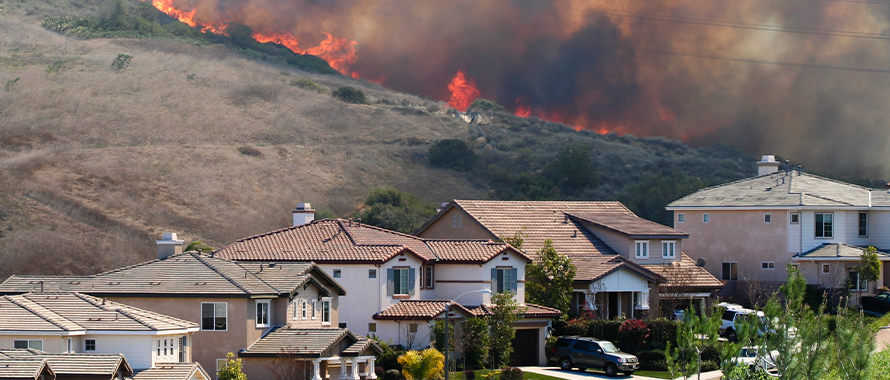This year has brought unprecedented challenges as the world copes with the COVID-19 pandemic; however, 2020 has also been a record-breaking year for extreme weather events: devastating wildfires, an especially active hurricane season, blackout-inducing heatwaves, a historic spate of tornadoes, a “firenado” and a 500-year flood.
The U.S. recently hit its 10th billion-dollar weather disaster of the year earlier than ever before and the hurricane season is on pace to become among the worst in recorded history—Tropical Storm Kyle recently became the earliest “K”-named storm ever to form in the Atlantic Ocean.
On August 10, a powerful derecho storm flipped vehicles and caused widespread property damage when it ripped through several Midwestern states. Tropical Storm Isaias hit Northeast and Atlantic states in early August and caused $20 million in damage. In the West, ongoing wildfires have so far scorched more than 190,000 acres in California, Colorado and Oregon.
California is also contending with rolling blackouts due to the worst heat wave in 70 years, leaving millions of residents in the dark. On August 18, California Governor Gavin Newsom declared a state of emergency in response to wildfires.
The recent wave of severe weather comes as people in the U.S. and around the world struggle with the economic and public health fallout from the COVID-19 pandemic.
“This year truly has been a perfect storm of events,” said Anthony Kobets, Broker, Burns & Wilcox, Overland Park, Kansas. “Everything is hitting at once, from the pandemic to natural disasters. This year we’re seeing more weather events earlier in the year than we are traditionally used to seeing.”
Fueled by climate change, the uptick in severe weather puts homeowners and businesses at risk for substantial losses if their properties are not adequately covered by Homeowners and Dwelling Insurance, Commercial Property Insurance, Flood Insurance and other policy types.
“These events are a continuation of what the industry has been experiencing over the last several years,” said Bill Gatewood, Corporate Senior Vice President, National Personal Insurance Practice Leader, Burns & Wilcox, Detroit/Farmington Hills, Michigan. “You really have to make sure that you have the right coverages and proper limits, because the worst thing that can happen is finding out you have an unfunded insurance loss or you have to pay out of your own pocket.”
Insurance market hardens as wildfires rage
So far, in 2020, there have been over 36,000 wildfires in the U.S. and more than 3,000 wildland fires in Canada. Each year since 2000, an average of 71,300 wildfires burned an average of 6.9 million acres in the U.S. — more than double the average annual acres burned in the 1990s.
On August 18 and 19, California fire authorities issued mandatory evacuation orders to residents in parts of Santa Cruz as well as in San Mateo, Napa and Sonoma Counties in Northern California, where thunderstorms brought lightning strikes that fueled more fires.

If you have a $1 million home and you do not increase your replacement costs for inflation for three years in a row, you could be underinsured by $200,000. Not many homeowners could afford that.
“Within the last five years, we have had 10 of the largest wildfires in California history,” said Ian Hanson, Associate Vice President, Underwriting Director, Burns & Wilcox, San Francisco, California. “As wildfires become larger and more frequent, insurance carriers are less willing to write large pockets of exposures in any one brush area.”
After the Camp Fire of 2018, the most deadly and destructive wildfire in California history, many insurance carriers stopped offering wildfire coverage, Hanson explained. Many Homeowners and Dwelling Insurance carriers in high-risk areas like California are excluding fires from policies and directing homeowners to purchase a standalone California FAIR Plan policy that only covers losses due to fire. Some Commercial Property Insurance carriers are beginning to follow suit, Hanson said.
As fire losses become more expensive over time, it is important for homeowners to consider their home’s replacement cost when evaluating insurance coverage. Extended replacement cost coverage is a beneficial enhancement that can help “cushion” homeowners in the event a rebuild project goes over budget.
“Construction costs have gone up quite a bit, and demand is high,” Hanson explained. “If you have a $1 million home and you do not increase your replacement costs for inflation for three years in a row, you could be underinsured by $200,000. Not many homeowners could afford that.”
Loss of use coverage, which pays for additional living expenses while your home is repaired or rebuilt, is another important consideration, he said.
Review coverage annually, take proactive measures to mitigate risk
Since 1980, the U.S. has experienced 273 weather and climate events that total more than $1.79 trillion in costs. The U.S. experienced 14 billion-dollar weather disasters in 2019, and experts believe that figure could be higher for 2020 if weather events continue at their current rate. Canada has seen a recent increase in tornadoes, with its 2020 total already nearly double the annual average. The Canadian Hurricane Centre responds to an average of three to four tropical cyclone events each year.
While natural disasters can cause hundreds of thousands of dollars in losses to homes, many homeowners find out too late that they are uninsured or underinsured. When Hurricane Harvey made landfall in 2017, roughly 80 percent of homeowners impacted by the storm were without Flood Insurance.
“Homeowners must make sure they are purchasing the right policy for their situation,” Gatewood said. “There is no time like the present for brokers and clients to talk through their insurance plan. We recommend an annual review for homeowners to be certain their policies adequately protect them and their assets.”
Most Homeowners and Dwelling Insurance policies do not include coverage for flood damage, Gatewood said. Flood Insurance is a separate insurance policy that a homeowner must invest in to have proper coverage for costs related to flood events.
In addition to the potential for uncovered expenses, homeowners should account for the inconvenience of a water-related loss and subsequent mold remediation in their policies. “There is a tremendous amount of expense and hassle that accompanies water damage,” Gatewood said. He explained that homeowners may be forced out of their homes for extended periods, unable to replace family heirlooms, and commonly wait a considerable amount of time for claims to be resolved. “This kind of damage can create a complete and total disruption to your life.”

There is no time like the present for brokers and clients to talk through their insurance plan. We recommend an annual review for homeowners to be certain their policies adequately protect them and their assets.
Terms are being altered on many Homeowners and Dwelling Insurance policies, including percentage-based wind and hail deductibles, and roof settlement provisions. Despite rising rates and deductibles, there are still choices in the Homeowners and Dwelling Insurance market. “One carrier may have made a change that will not be right for your situation, but another carrier may offer the coverage you need,” said Gatewood. “Things are changing rapidly, so this is an especially good time to look into the market.”
Beyond insurance, homeowners in high-risk areas should be proactive about reducing their risk of loss in the event of a natural disaster. Stronger window glass, shutters, roof reinforcements and other measures can help mitigate the risk of a hurricane, while planting non-combustible foliage and avoiding flammable mulch around a home are recommended for homeowners in areas prone to wildfires.
Burns & Wilcox also offers a partnership with Wildfire Defense Systems, which provides wildfire prevention and mitigation services to homeowners in certain areas as an added benefit with their Homeowners and Dwelling Insurance coverage.
“The return on the investment in the Wildfire Defense Systems service in the event of a fire can be significant, especially on second or vacation rental homes that are frequently unoccupied,” Hanson said. “The service is especially helpful now, in the midst of the pandemic, when travel is limited or undesirable.”
“Wildfire Defense Systems has tips and direction on what homeowners can do to make their homes a little more defensible against a wildfire,” explained Gatewood. “You certainly cannot prevent a wildfire or any natural disaster, but there are things you can do to potentially lessen the damage to your property,” Gatewood said.
Business interruption coverage can minimize financial fallout
As natural disasters become both more common and more extreme due to climate change, commercial property owners are also at risk for financial losses from severe weather events. A middle school and a church in Delaware were condemned after sustaining damage during Tropical Storm Isaias earlier this month, and business owners in Colorado recently related the financial toll of ongoing wildfires.
“Weather events are occurring more often from the Midwest to the East Coast, heavy rain and flooding like Iowa and Nebraska experienced recently are increasingly common, and droughts are more frequent from Colorado to the West Coast,” Kobets said. “It has been trending this way for a few years.”

You need to be focused on not just price but on the coverage you are getting. It is critical that you have a reputable broker or agent you can trust and work with to find out what you really need.
Derecho storms, in particular, pose a unique risk because of their hurricane-like conditions that are widespread and long-lasting. The derecho storm that hit the Midwest earlier this month caused an estimated $3.9 billion in damages. These types of storms have become more frequent in the Midwest over the last 10 years, according to Kobets.
Commercial Property Insurance can cover weather-related property damage and may also include business interruption coverage for loss of business income related to the weather event. “Reviewing your building and contents limits as well as your loss of business income and extra expense coverage is essential, as is having policies properly written and reviewed by an insurance broker or agent,” Kobets emphasized.
Due to the increase in severe weather events, the Commercial Property Insurance market has hardened. “We are seeing a mix of increased deductibles as well as rates,” Kobets noted. “There can be multiple exclusions on a policy, so it is important to review your policies. You do not want to be in a situation where you are paying for a policy that will not cover you properly.”
In times such as these, working with a trusted insurance broker or agent is even more important. “It is a partnership,” Kobets said. “You need to be focused on not just price but on the coverage you are getting. It is critical that you have a reputable broker or agent you can trust and work with to find out what you really need.”
Join Bill Gatewood and Ian Hanson for a Q&A with Wildfire Defense Systems CEO Dave Torgerson at 1:30 p.m. Thursday, Aug. 27. Register here.






